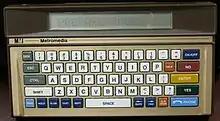Telocator Alphanumeric Protocol
Telocator Alphanumeric Protocol (TAP) is an industry-standard protocol for sending short messages via a land-line modem to a provider of pager and/or SMS services, for onward transmission to pagers and mobile phones.[1][2]

TAP, initially known as Motorola Page Entry (PET) was adopted in September 1988, by the Personal Communication Industry Association. TAP defines an industry standard for sending alphanumeric messages to pagers.
TAP was also known as IXO protocol. Originally, devices like the IXO Device were used to send Alphanumeric Pages using TAP. Later, Motorola would create a similar device called the AlphaMate.
TAP Communication Protocol
The standard protocol is ASCII with XON/XOFF flow control, using a 10-bit code (1 start bit, 7 data bits, even parity, 1 stop bit). No echo shall be employed in full duplex mode.[3]
See also
References
- "Archived copy" (PDF). Archived from the original (PDF) on 2006-10-24. Retrieved 2008-08-11.
{{cite web}}: CS1 maint: archived copy as title (link) - "Alert via Cell Phone". Archived from the original on 2008-06-27. Retrieved 2008-08-11.
- Telocator Alphanumeric Protocol (TAP), Version 1.8, February 4, 1997
External links
- Directory of TAP Dialup Numbers from avtech.com
- Directory of TAP Dialup Numbers from notepage.net
- Universal TAP Gateway from tapgateway.com
- http://www.braddye.com/a_entry.html
- http://www.tapgateway.com/files/TAP_V1P8.pdf
- http://www.pageone.co.uk/downloads/developer/TAP_Document.pdf (version 1.7)